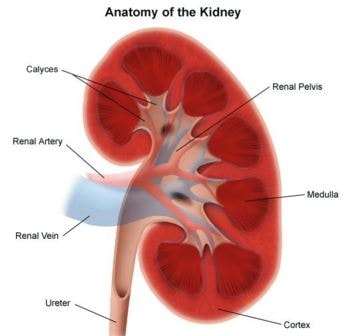Caliectasis
What is Caliectasis?
Caliectasis is a type of kidney problem wherein the calyces of the kidneys become enlarged. These calycles are the kidney chambers where the urine passes through and is divided into two groups; major and minor.
The minor calycles are the ones that surround the top of each renal pyramid. The urine which is formed in the kidneys goes through the renal papilla at the tip and gets to the minor calyx. The dissimilar minor calycles somewhat merge together and made the major calycles. These newly formed calycles are the passage of urine before arriving at the area of the ureter and the renal pelvis.

What are the Symptoms of Caliectasis?
Below are the most familiar symptoms of Caliectasis:
- Kidney area becomes sensitive during palpitations
- Having a hard time urinating
- If the dilation constantly recurs, the person may not feel any severe pain but more precisely a dull discomfort
- Blood might be present in the urine; this is referred to as hematuria
- The area of the kidneys are quite sensitive during palpitations
- Inflammation in the kidney area is available in some individuals
- Nausea and vomiting may also occur as systemic symptoms
- A throbbing ache might be felt in the kidney area specifically in the space separating the hips and the ribs and can get irritated by merely touching
- In case of acute infections, pus which is a yellow-white substance formed at the swollen part, can be removed through the urine as accompanied with a foul odor
What are the Causes of Caliectasis?
There are numerous of causes that are common which results to the appearance of caliectasis and these include:
- Blockage of the urinary tract – The tract can be obstructed with kidney stones, iatrogenic effects, and malignant growths.
- The urinary tract being impeded by blood clots
- A woman’s pregnancy when the fetus is pressed on the ureters, resulting to the bloating of the calyces, among other symptoms
- Altered flow of urine into the kidneys caused by the unusual tightening of the muscles of the bladder, flexing of the bladder, prostatic growth, and the build-up of feces in the colon
- The infection of the urinary tract when the calyces becomes swollen
- Cancer in the bladder
- Harmful growths in the section of the bladder or influencing the urethra or ureter
- Enlargement of the prostate
- Retroperitoneal fibrosis
- Structural malformations – This happens during the development of the fetus, causing the emergence of hydronephrosis; radiation therapy; a condition that had been inherited from the family; surgery; and injury.
Diagnosis
Patients who are diagnosed with this condition are commonly treated by a urologist, a physician who specializes in the care of the urinary tract. The first thing to be done by the urologist is an ultrasound investigation, wherein an ultrasound image will present the swollen kidneys and the dilation of the calyces.
The ultrasound can be of use in knowing whether there is a certain blockage in the area or not. Another useful test is the Intravenous urography, wherein X-rays are being used and a special dye will be injected to assess and see a visualization of the area surrounding the calyces and the kidneys.
Additional diagnostic tests include:
- Complete blood count
- When the levels of white blood cells are high, this means that there is an infection in the body
- Electrolyte imbalances
- The tests for the kidney function can be based on the elevation of creatinine and urea which means that if it’s high, the kidneys function poorly
- Urine analysis – To diagnose the urinary tract since the patient might present hematuria or blood found in the urine and an upraised pH happens when the nephrons of the kidneys are terminated by the continual distension
- Physical examination
How is Caliectasis Treated?
There are several treatment options for a patient with Caliectasis which should be discussed well with both the patient and the physician along with its strengths and weaknesses.
Treatments that can be taken include:
- Kidney drainage procedure – This procedure’s purpose is to remove any stones that has caused a blockage in the urinary tract and it is done by draining out the urine to relieve the pressure.
- Antibiotics – Oral administration is much recommended but any of these antibiotics should be taken based on the physician’s prescription.
- Surgery – This option is for patients who have kidney stones that are too massive to be passed and for those individuals who present different malignant growths.
- Insertion of catheter
- Insertion of nephrostomy tube
Caliectasis versus Hydronephrosis
Generally, hydronephrosis means water in the kidney. It is associated with caliectasis and both of these should be treated right away since the kidneys of the patient might waste away causing their function to be entirely disabled having a great effect on the person’s quality of life.
Treating the symptoms of hydronephrosis and caliectasis at the right time is very important in order to stop potential renal failure and emaciation of the kidneys.
References
- Caliectasis – Definition, Symptoms of Caliectasis, Causes, How is Caliectasis Diagnosed?, Treatment at http://healthh.com/caliectasis/
- http://www.wisegeekhealth.com/what-is-caliectasis.htm
- What does mild caliectasis of kidney mean? And stasis of urine in right proximal ureter? Source: HealthTap, https://www.healthtap.com/user_questions/284661-what-does-mild-caliectasis-of-kidney-mean-and-stasis-of-urine-in-right-proxim at https://www.healthtap.com/user_questions/284661-what-does-mild-caliectasis-of-kidney-mean-and-stasis-of-urine-in-right-proxim
- Toka HR, Toka O, Hariri A, Nguyen HT (July 2010). “Congenital anomalies of kidney and urinary tract”. Semin. Nephrol. 30 (4): 374–86.
- Chong, TW; Bui, MH; Fuchs, GJ (Nov 2000). “Calyceal diverticula. Ureteroscopic management.”. The Urologic clinics of North America 27 (4): 647–54.
- Krzeski, T; Witeska, A; Borówka, A; Pypno, W (September 1981). “Diverticula of renal calyces”. International Urology and Nephrology 13 (3): 231–235.
